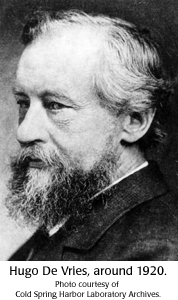Concept 6 Genes are real things.




 Hugo de Vries, Carl Correns and Erich von Tschermak-Seysenegg were the three scientists who rediscovered Mendel's laws in 1900. They were all working independently on different plant hybrids, and came to the same conclusions about inheritance as Mendel. Robert Hooke was one of the first scientists to describe a cell. Theodor Schwann redefined the cell as a living unit.
Hugo de Vries, Carl Correns and Erich von Tschermak-Seysenegg were the three scientists who rediscovered Mendel's laws in 1900. They were all working independently on different plant hybrids, and came to the same conclusions about inheritance as Mendel. Robert Hooke was one of the first scientists to describe a cell. Theodor Schwann redefined the cell as a living unit.
Hugo de Vries (1848-1935)

Hugo de Vries was born in Haarlem, Netherlands. He was a Professor of Botany at the University of Amsterdam when he began his genetic experiments with plants in 1880. He completed most of his hybridization experiments without knowing about Mendel's work. Based on his own results, de Vries drew the same conclusions as Mendel. De Vries published his work in 1900, first in French then in German. In the French report there was no mention of Mendel, but this was amended by de Vries in the German paper. It is possible that de Vries read Mendel's paper before he published his own, and included Mendel's name in the later printing when he realized that other people also knew about Mendel's work. De Vries may have thought that his own conclusions were superior to Mendel's.
De Vries was also a strong proponent of the idea of discontinuous variations. De Vries believed species evolve from other species through sudden, large changes of character traits. De Vries based this "theory of mutation" on work he did using Oenothera lamarckiana — the evening primrose. He observed that the original plant would occasionally have offspring with significant phenotypic differences such as leaf shape and plant sizes. Some of the offspring would pass the new "sport" (mutation) to their progeny; these de Vries designated as new species.
It is now known that de Vries had the right idea, but for the wrong reasons. Most of the variants that de Vries isolated from Oenothera lamarckiana were due to aberrant chromosomal segregations, and not to mutations associated with specific genes.


Theodor Schwann recognized that eggs, ova, are cells. In 1841, sperm were classified as cells when they were seen developing from testis cells.

What is the largest single cell in existence?
 Children resemble their parents.
Children resemble their parents. Genes come in pairs.
Genes come in pairs. Genes don't blend.
Genes don't blend. Some genes are dominant.
Some genes are dominant. Genetic inheritance follows rules.
Genetic inheritance follows rules. Genes are real things.
Genes are real things. All cells arise from pre-existing cells.
All cells arise from pre-existing cells. Sex cells have one set of chromosomes; body cells have two.
Sex cells have one set of chromosomes; body cells have two. Specialized chromosomes determine sex.
Specialized chromosomes determine sex. Chromosomes carry genes.
Chromosomes carry genes. Genes get shuffled when chromosomes exchange pieces.
Genes get shuffled when chromosomes exchange pieces. Evolution begins with the inheritance of gene variations.
Evolution begins with the inheritance of gene variations. Mendelian laws apply to human beings.
Mendelian laws apply to human beings. Mendelian genetics cannot fully explain human health and behavior.
Mendelian genetics cannot fully explain human health and behavior.